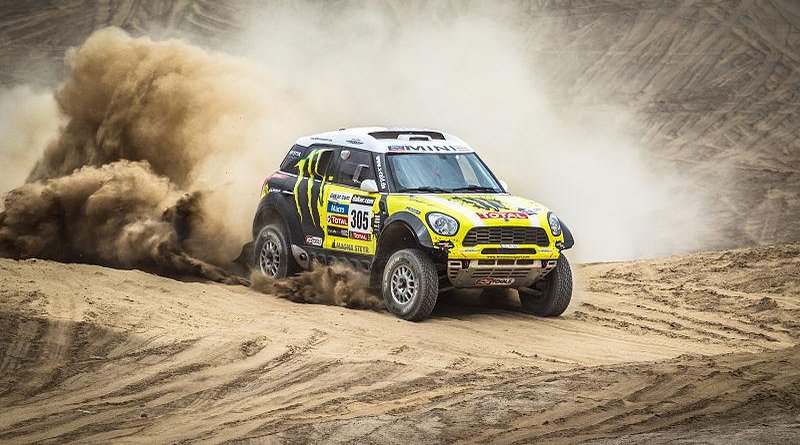Sands Of Time Brought Dakar Back To Its Beginnings – OpEd
By Arab News
By Michael Reininger*
With the Dakar Rally finishing recently in Saudi Arabia and the final podium being at the Qiddiya site, it did in a sense return to its roots: For it was in desert sands that the rally was born, and it is to desert sands that it has now reverted.
The story started 43 years ago, in 1977, when the French adventurer Thierry Sabine became lost in the Tenere desert of North Africa while racing his Yamaha XT 500 enduro motorcycle in a rally from Abidjan to Nice. Alone in the middle of this vast desert for three days, he ran out of food and water: A situation that for most would produce panic, but for him was the setting for inspiration. To settle his mind, he rubbed his “gri-gri” — a leather amulet that had been gifted to him by a Tuareg friend. By the time he was rescued and was being flown to safety, Sabine’s mind had settled on a bold vision.
His idea was like something out of “Mad Max” — a rally across the Saharan sands not just for motorcycles but for cars and trucks too, and not just for professional drivers but for amateurs as well. It came together quickly. The scene at the start of the first Paris-Dakar Rally on Dec. 26, 1978, was a motorsport menagerie, with 182 vehicles revving their engines at Place du Trocadero; the drivers giddy with eagerness to bid the arrondissements adieu and set off for the Sahara.
Seventy-four vehicles would reach Dakar; the other 108 could not conquer the challenge of the sands.
The race, photogenic to the extreme, captured popular imagination and Paris-Dakar became synonymous with adventure. But, after some difficult years — Sabine’s death in a helicopter crash during the 1986 rally, numerous accidents, and political and security concerns in North Africa — organizers decided that the race should take a lesson from its drivers and hit the open road.
And so began Dakar’s second era. In 2009, the race shifted camp (and continents) to South America. But even during this stint amid the pampas, it retained its connection with the desert. The route through Argentina and Chile included a section in northern Chile’s Atacama Desert, one of the driest spots on the planet. It was the Atacama that hosted a milestone for Saudi motorsports, when Yazeed Al-Rajhi of Riyadh, piloting a Toyota car, in 2015 became the first Saudi driver to win a Dakar stage. He crossed the stage’s finish line in Iquique in a time of 3 hours, 26 minutes and 49 seconds, ahead of his nearest competitor by 72 seconds.
More recently, in November 2019, Al-Rajhi won the inaugural AlUla-Neom Cross-Country Rally in northern Saudi Arabia. Formula One veteran Fernando Alonso also competed, and came third. Alonso said afterwards: “It was a good four days’ preparation for the Dakar and discovering new terrain and new things here. To be third in the final two stages and to be third overall is the first podium of my life in rally. It is good that it happened now and gives us confidence for Dakar.”
Which brings us to the third era of the Dakar Rally. Forty-three years after Sabine’s vision in the desert, the race this year arrived in Saudi Arabia as part of a 10-year agreement with the General Sports Authority.
The 2020 edition started in Jeddah on Jan. 5, with Al-Rajhi, in his Toyota Hilux 4×4, among the 557 competitors taking part. The drivers crisscrossed the country, covering almost 7,900 km of dunes and tracks before finishing southwest of the capital Riyadh on Jan. 17, with Qiddiya hosting a special 20 km Qiddiya Grand Prix race as the last part of the event.
This grand finale at Qiddiya was a taste of things to come at the site. We are currently building the new motorsports capital of the world, with an unparalleled range of attractions. The launch of our first phase in 2023 will include a speed park with an FIA Grade 1 track as one of three anchors. Our long-term motorsports plans include a range of racing facilities, which will be revealed soon.
But back to a successful Dakar. Modern technology meant 2020’s drivers did not fear becoming as dreadfully lost as Sabine did during his long-ago sojourn in the Tenere. If any of them did find themselves even briefly alone on the sands, let’s hope they could comfort themselves with the thought that they were touching one of the constants of Dakar history: The majesty and inspiration of desert.
• Michael Reininger is CEO of Qiddiya.

